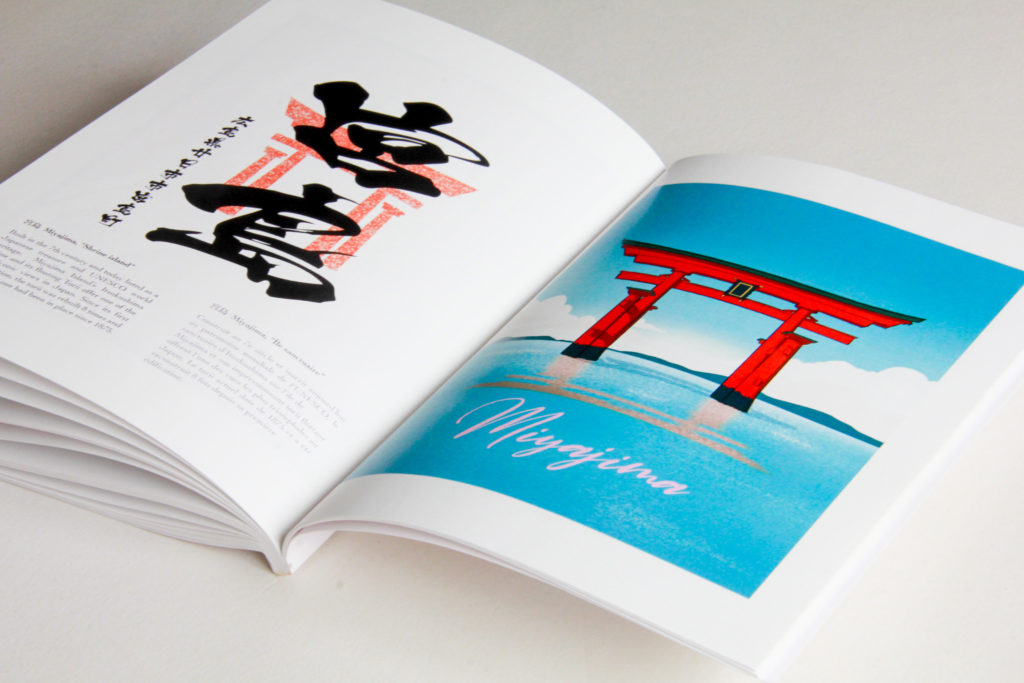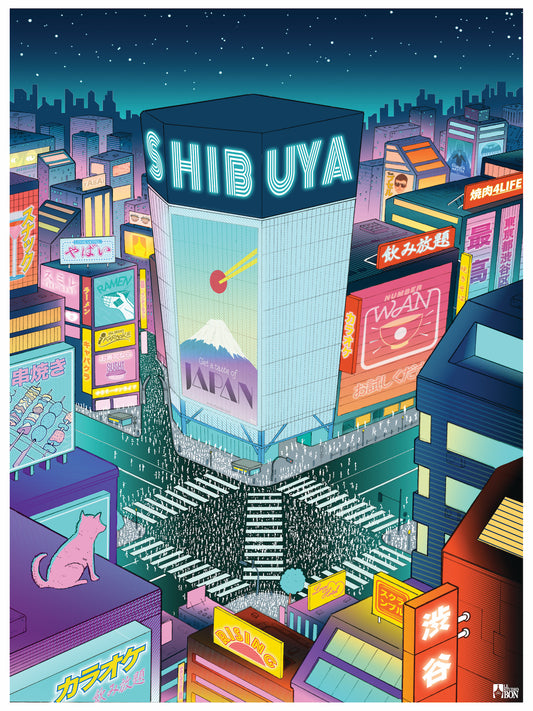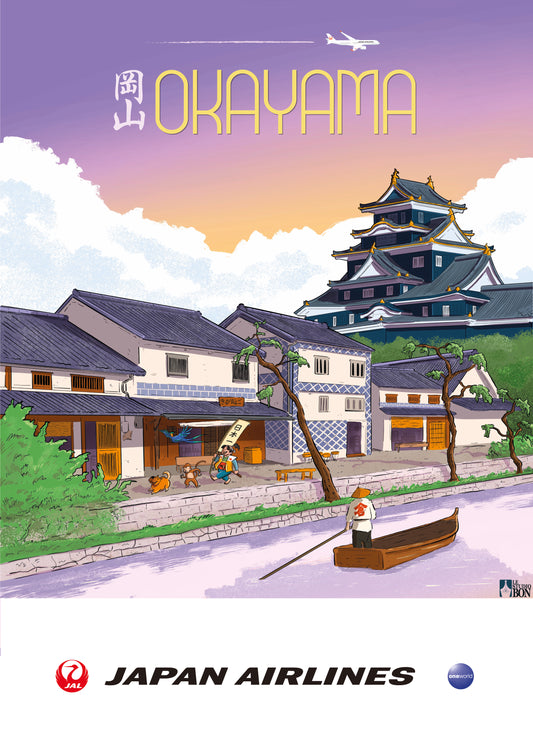Bon Voyage Japon: posters for a superb illustrated travel diary!
Born from the hand of a French artist living in Japan for more than 10 years, Bon Voyage Japan is the first volume of a future collection of tribute books, in the form of an artistic travel diary. Its originality: the works are based on the poster model and are associated with calligraphy inspired by goshuin, the stamps that visitors to the temples collect. Journal du Japon takes you to meet Jean Freund, the artist behind the posters, and his first work.
Journal du Japon: Hello Jean and thank you for your time. To start, can you introduce yourself? What was your path to becoming an illustrator?
Jeans : Hello and thank you for this interview. I am originally from Colmar in Alsace where I have always been immersed in a bilingual culture. Thanks to the close links that exist between my region and Japan, I had the chance to study Japanese from high school, then at the University of Strasbourg, finally landing in Tokyo where I have lived for 11 years.
I never studied drawing, I believe it is something that is part of our family heritage. My grandfather, who painted a lot in his spare time, influenced me a lot; it was for one of his collections of poems that I published my first drawing at the age of 10, I think. It was my finest hour, it took me a long time to post again!
There were periods in my life when I drew a lot, others when I composed a lot of music, and drawing returned around 2011 in Tokyo. I needed to escape from a job I was only mildly enjoying, so whenever I had time, I would pick up a pen. Little by little, I defined my style, developed my creations, responded to orders. It takes time and illustration has long been a side hustle.
How did you build your graphic style? Did you have any particular influences?
If we talk about my current style, I believe there are two particular influences. First of all, my parents always collected enameled advertising plaques which were popular in the 20th century and they are everywhere in their house, some are 2 meters high. They have powerful graphics, with fonts that stand out to you, they are colorful and present original constructions. I think they are well imprinted on my unconscious. Then, there are the Tintin albums that I collected when I was little and whose cover alone invites you to travel and adventure. It is certainly this comic format that pushed me to make vertical drawings in portrait format. An Alsatian artist who speaks to me a lot is Tomy Ungerer , who was able to make seemingly simple but actually very intelligent illustrations in different styles. I am obviously a fan of the posters of Embroiders or Kawase HASUI , but these are artists that I knew later. 4 years ago I discovered Laurent Durieux , a Belgian artist who reinvents cinema posters, he has a crazy talent for telling a story with a simple poster through details and winks.
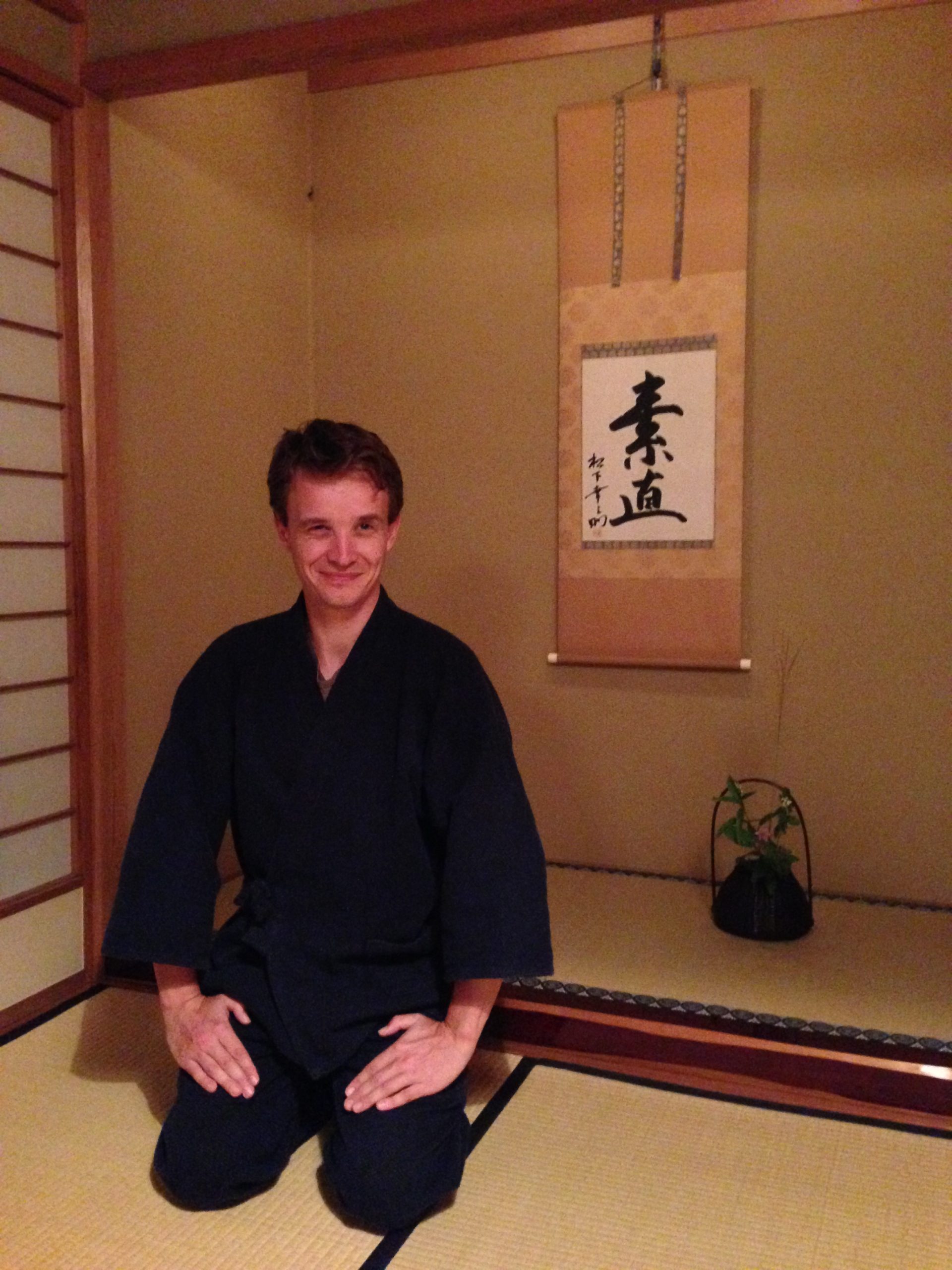 What was your first encounter with Japan?
What was your first encounter with Japan?
In first grade I had the opportunity to go to Japan with my Japanese class. 17 years old on the other side of the world, in an Asian culture: I had an immediate culture shock. We were with a host family, it was a great experience. I spoke very poorly at the time and that made me want to persevere.
Why did you choose to settle in Japan?
I chose to settle there because my goal since I was 17 was to master the language. I was ready to do anything to speak Japanese and have unexpected experiences. I was hungry for adventure and the challenge that presented itself to me excited me.
What do you like about this country, and what makes you still here after 11 years?
The Japanese language has a lot to do with it. I am a linguist, so speaking in a foreign language fascinates me and writing ideograms is very similar to drawing. I find this feeling in China too. In Europe I have less this stimulation. It should also be added that the Japanese are very welcoming, friendly people and we feel safe all the time. The notion of the group being more important than that of the individual, we also feel a strong social cohesion, particularly through the different festivals (matsuri) which punctuate the year. Similar events took place in my native Alsace but there is an exotic side that I never tire of. There are of course aspects of France that we don't find here and which I miss a lot.
How did you come up with the idea for the Bon Voyage project?
I have always drawn while traveling: Japan, China, the Trans-Siberian journey, Asia... and my creations aim to pay homage to these places that I visit, while remaining personal memories above all. With the Bon Voyage collection, I want to offer the reader an escape, a rediscovery of a place, a starting point for traveling through the imagination. Each reader can actually identify with my drawing and find memories there. The idea came to me when I was looking to make a book with all the posters I had. I thought about an original concept that could appeal to anyone, regardless of their native language. Because even if there is a little text in the book, the most important thing is the drawing. Moreover, often during my travels when I cannot communicate in the local language, I use a sketchbook, and I can have limited but interesting conversations!
How did you construct this work on Japan?
I wanted to make an intercultural work that fits into the theme of travel. On the one hand, we have the posters in a very Western style. On the other, Japanese calligraphies in the Goshuin style which are still collected today in temples, and which constitute proof of his passage in this place. It was my pilgrimage to Shikoku that inspired this idea.
There seems to be a desire to present Japan through the seasons, why this choice?
In reality this is not intended! It turns out that I have a visual that I had declined under the 4 seasons and I chose to disseminate it here and there. However, we can point out that the seasons in Japan are very marked, and that the Japanese often remind you that “Japan has 4 seasons!” We can see this as a wink.
What tools do you use to create your works?
The vast majority of my drawings are done by hand in a notebook that I carry with me, then scanned and colored on a computer. Many of my creations are really the fruit of my travels and encounters, which is why I want to preserve this creative process as much as possible. Handmade also adds something authentic and its imperfections give a dose of humanity, I think. Some of my creations are made entirely on the computer with a mouse but the result is too “clean” for my taste and we lose this authenticity. Some people are very good at making a drawing on the computer but don't know how to use a pencil. Just like a DJ can sample guitar or piano loops without knowing how to play an instrument. I am not denigrating this method, but in my case I need to know how to use both sides, analog and digital.
Can you present 2 of your creations to us by explaining their history and the composition choices?
The poster that marks many people is the one entitled “Get a taste of Japan” (“come and taste Japan”) which has Mount Fuji in the background and above a red circle held by 2 chopsticks.
This creation is interesting because it is very intercultural: ask a Japanese what the red circle represents, they will answer “Umeboshi” (a sour plum served on rice). Ask a Westerner the same question and they will answer “the (rising) sun”. In reality the 2 answers are the same and what is important is to understand the idea of “taste/discover” Japan. I like when my creations have this kind of multiple interpretations. The idea came to me while I was working on a logo for a friend but it was rejected. This creation alone represents Bon Voyage Japan and all my work here.
The lessons mixed Japanese management, cult of personality, field experience, politics courses, neo-religion, learning the Japanese “ways” and sport. The typical day started at 5:45 a.m., with 1 hour of sweeping outside, prioritizing roles and tasks. Then 4 km of running on the beach. After breakfast, we put on our suits and ties to proclaim out loud, in a line, the values of the Institute once we have finished reading a sermon from Matsushita Konosuke's book. It's 8 o'clock, so politics or history lessons follow. The afternoon could be devoted to 5 hours straight of learning tea ceremonies, or 2 hours of Kendo (sword art), or why not go planting rice by hand. At the end of my 7 months of participation, we had to walk 100km in less than 24 hours. I spent 7 months in a completely Japanese environment, subjected to the harshness of the Japanese vertical hierarchy, facing linguistic difficulties that I was unaware of, but in the end it was a rich and unforgettable experience. After the Matsushita Institute I had the feeling of having achieved my goal that I had set for myself at 17 and everything now seemed possible. I think that's when the “Bon Voyage Japon” seed started to germinate, which is why this poster speaks to me a lot.
Food seems to hold an important place in your works, can you explain your connection with it?
Tokyo is full of restaurants, some open all hours of the night, and the Japanese food is excellent. In France during my student life I didn't go to restaurants too much, today like many Japanese I go there very often. For a Westerner, Japan also offers all kinds of exotic or unexpected dishes, and I have always enjoyed trying raw octopus or biting into a still squirming fish. The use of chopsticks is a very strong cultural trait, which is certainly why they often appear in my drawings.
At Journal du Japon, we particularly liked Tokyo Metro And Kyoto , can you explain to us how they were built?
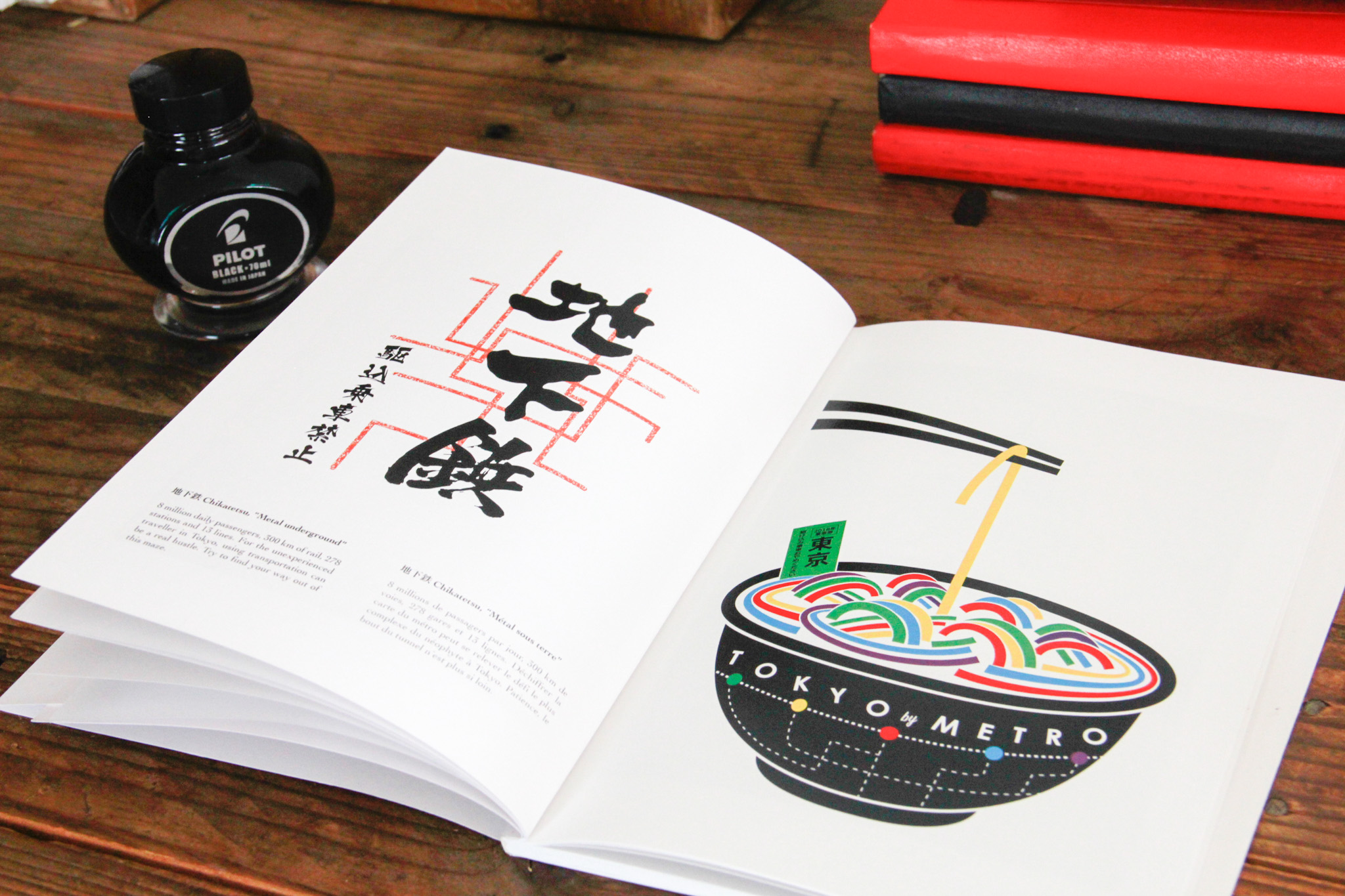
Tokyo Metro reminds me of my years as a neophyte in Japan, when I took the subway and the map seemed incomprehensible to me at first glance. It looked like a ball of wool or intertwined earphone wires, it was so dense and tangled that it almost seemed like a joke to me. I know that many visitors to Japan have the same experience, so I wanted to transcribe it in a way that it speaks to everyone. I was in a “ramen” period and suddenly the idea of making a bowl of noodles seemed obvious to me. We find the cultural features of Japan (chopsticks, bowl of ramen) and the metro (lines by color, mini map of the tracks on the bowl and the metro ticket as dried seaweed). If this had been an Italian city I would definitely have made a spaghetti dish!
Kyoto is a city full of places to visit and unless you stay several days you are forced to make a selection. That's a bit of the idea of the drawing. The idea of putting the city in a bento box comes from city planning. Kyoto is in fact built on a checkerboard structure, like New York for example, with vertical and horizontal streets. The quarters are compartmentalized, like a bento.
Mount Fuji and the torii are the two Japanese symbols found most in your works, what do they represent to you?
Mount Fuji is certainly the quintessential symbol of Japan and even as a child I understood what it was referring to. It is a truly majestic and powerful mountain, which you can see from very far away and yet when you are right next to it you may not see it because of the clouds. Living in Tokyo, seeing Mount Fuji is always satisfying for me. From my native Alsace plain I had the habit of situating myself in relation to the German mountains to the east and the French mountains to the west. Mount Fuji is a bit of my compass.
What are you trying to convey through this work?
This work is for me a tribute to Japan and the places I love. I want readers to be able to (re)discover the country and re-appropriate my posters as their own memories. Unlike a realistic photo taken thousands of times by thousands of people, my drawings appeal more to the imagination, they are a re-interpretation of reality more than a copy. If when you see my posters you want to go to Japan, if they remind you of a memory or make you dream, then my goal has been achieved.
What are you waiting for for the rest of Bon voyage?
I still have a lot to tell and share about Japan, it is possible that I will decline other ideas to include them in the Bon Voyage collection.
More generally, after Japan I would like to expand to other destinations by adapting the concept to the cultural specificities of each country. I might not be able to do calligraphy for the France destination as I did for this book, something else will have to be defined. But that's what's interesting, knowing how to reinvent yourself to adapt.
I have traveled a lot in China, a country that fascinates me with its language and diversity of landscapes. At the moment I already have around fifteen posters ready, ranging from the natural skyscrapers of Zhangjiajie to the Uighur grape cultures in the desert. Maybe it will be the next volume. I also have illustrations of a plane-free trip from Japan to France via the Trans-Siberian Railway . And of course I can't wait to do the one on Alsace!
The crowdfunding campaign that I launched aims to bring together a community of Japan lovers and to be able to make them aware of my work through the book, but also through original screen prints that I offer or participatory drawings that I create with them. Thanks to this support and this desire for discovery, we will be able to go even further with new volumes.
My goal is therefore to take my audience on a journey through my posters, so that in 5 or 10 years a series of destinations from the famous Bon Voyage collection will proudly sit on our libraries. And that the people who believed in me at the beginning can say “I am one of the founding members of this collection”.
Thanks to Jean for this interview. The crowdfunding campaign has already reached the 3rd level with more than 300 contributors and we wish great success to this new project which highlights Japan and its cultural specificities. To follow the progress of the Bon Voyage Japon project and Jean's adventures, go to his instagram And his facebook .



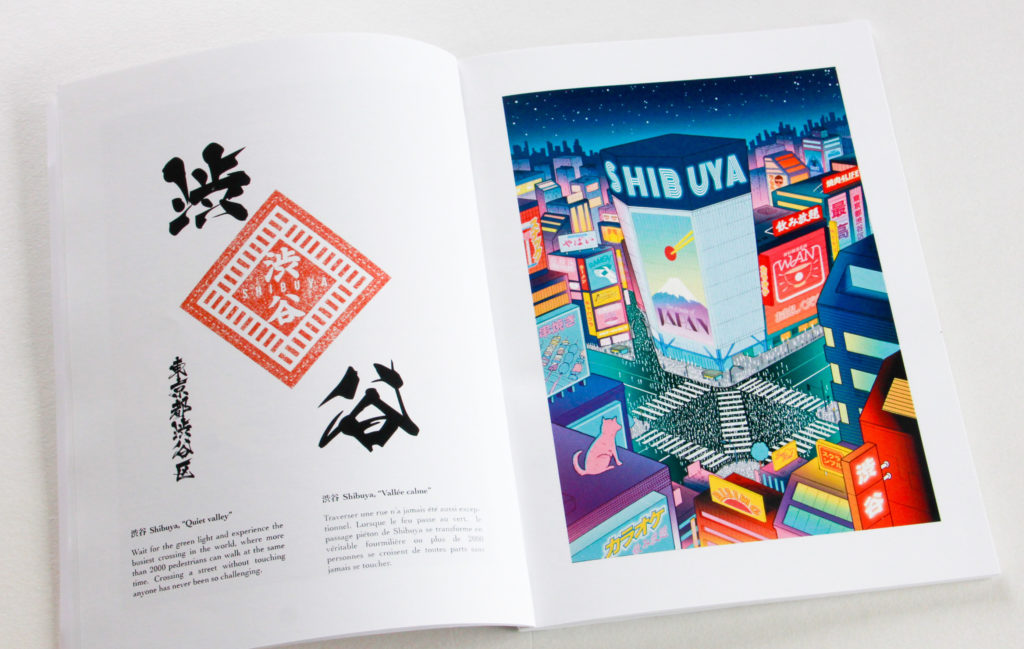
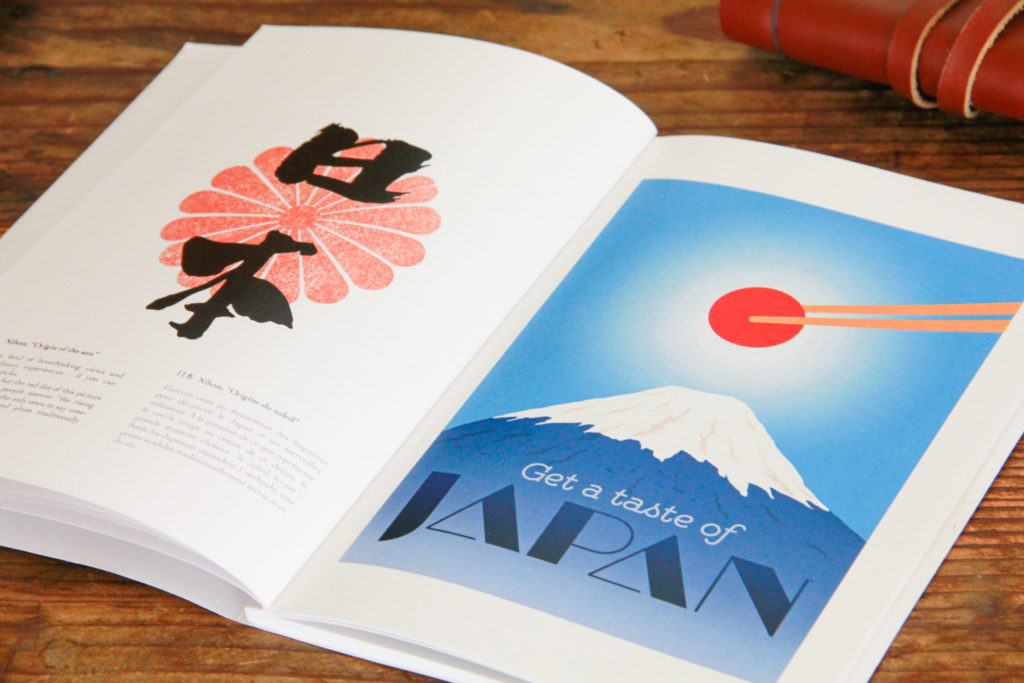
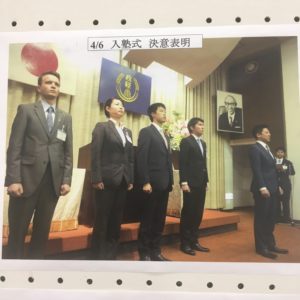 The second poster will not speak to many people, but is for me inseparable from my life in Japan. This is the poster
The second poster will not speak to many people, but is for me inseparable from my life in Japan. This is the poster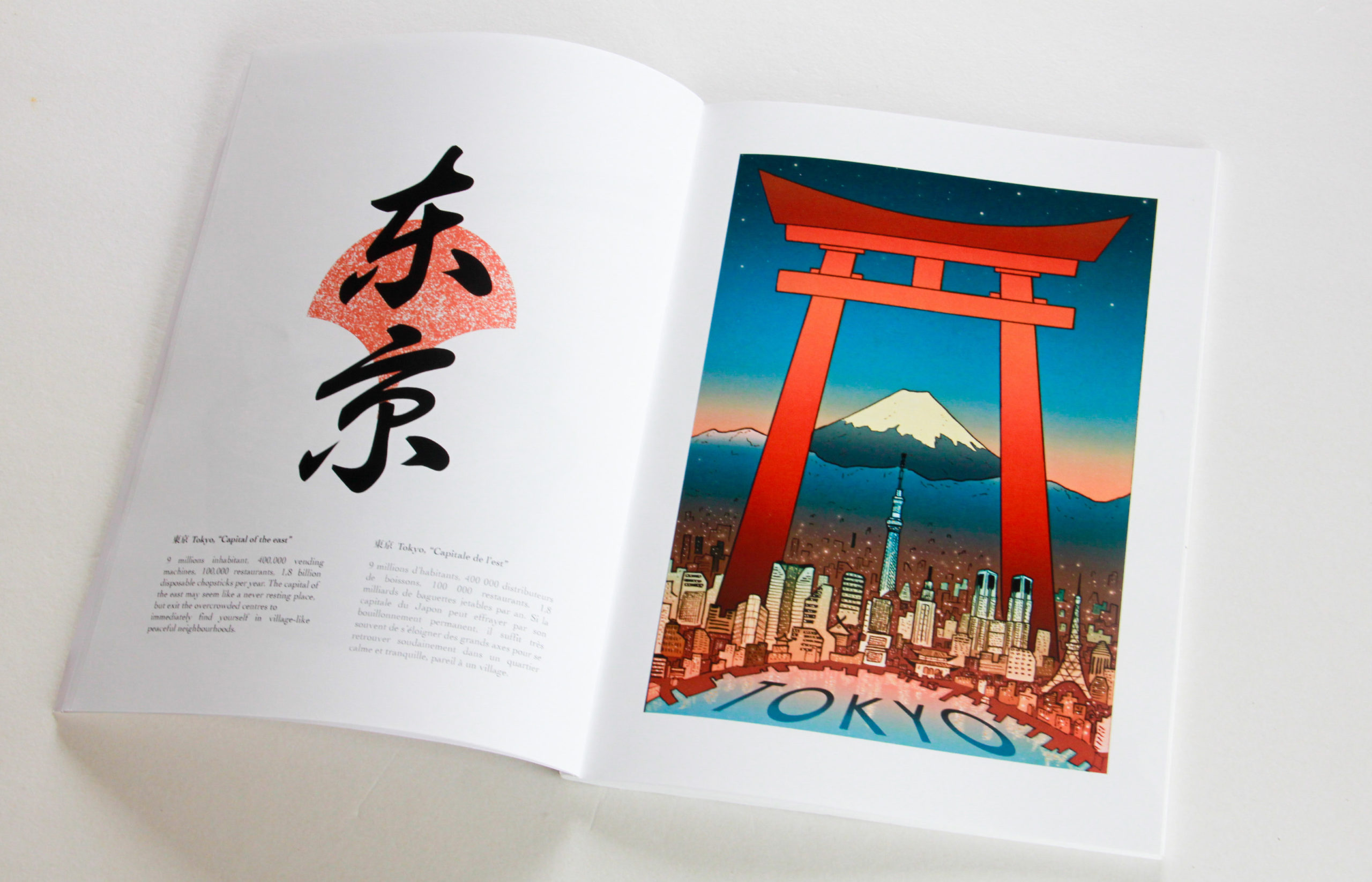 The torii are also a very strong Japanese cultural trait, as the Shinto religion does not exist elsewhere in the world. I like the idea of the portico which opens to a sacred space. There are very basic torii and other very sophisticated ones, some red, others made of wood, recently in Hokkaido I discovered my first metal torii! I don't practice religion but I really like the polytheistic idea of Shintoism, its absence of absolute vision of good and evil and veneration of nature. When I was at the Matsushita Institute I had the chance to participate in the Shinto ceremony of Shikinen Sengu of Ise, a tradition which only takes place once every 20 years and is 1,300 years old. It consists of transferring the soul of the sun goddess Amaterasu to an identically constructed sanctuary, right next to it, and then dismantling the current one. I have rarely had such a strange experience, we were a very limited number of spectators and the participants were all dressed in their traditional clothes of priests or others, I had the impression of taking a leap into the past. It was very memorable, the torii always reminds me of this experience.
The torii are also a very strong Japanese cultural trait, as the Shinto religion does not exist elsewhere in the world. I like the idea of the portico which opens to a sacred space. There are very basic torii and other very sophisticated ones, some red, others made of wood, recently in Hokkaido I discovered my first metal torii! I don't practice religion but I really like the polytheistic idea of Shintoism, its absence of absolute vision of good and evil and veneration of nature. When I was at the Matsushita Institute I had the chance to participate in the Shinto ceremony of Shikinen Sengu of Ise, a tradition which only takes place once every 20 years and is 1,300 years old. It consists of transferring the soul of the sun goddess Amaterasu to an identically constructed sanctuary, right next to it, and then dismantling the current one. I have rarely had such a strange experience, we were a very limited number of spectators and the participants were all dressed in their traditional clothes of priests or others, I had the impression of taking a leap into the past. It was very memorable, the torii always reminds me of this experience.